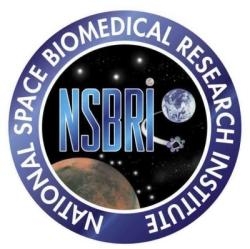Wed, Aug 21, 2013
Soliciting For A Center For Space Radiation Research
The National Space Biomedical Research Institute (NSBRI) is soliciting for program proposals to establish a Center for Space Radiation Research (CSRR). The CSRR will build upon important discoveries made by the NSBRI Center of Acute Radiation Research and extend them by characterizing and quantifying the effects of space radiation on living systems. Operating in close partnership with NASA's Human Research Program, the CSRR will be tasked with researching the acute effects of space radiation, as well as the longer term, so-called "degenerative" effects of space radiation on the cardiovascular and circulatory systems. Accordingly, the CSRR will work to reduce the radiation related health risks that will be encountered by astronaut crews during future missions to an asteroid, the Moon or Mars. This research announcement entitled "Center for Space Radiation Research" was released by NSBRI on August 14, 2013.

The CSRR will combine exposures to both solar and galactic particles, thereby more closely mimicking the environment actually experienced by astronauts during exploration missions. Pharmaceutical countermeasures will also be evaluated for their ability to mitigate the harmful effects of space radiation. Scientific discoveries made by the CSRR will not only enable safe and productive human exploration of space, but may also have the potential to improve life on Earth.
The CSRR will use a systems biology approach to characterize the effects of space radiation by combining physiological observations with new 21st century integrated -omics techniques, such as genomics, proteomics and metabolomics. This strategy will facilitate the correlation of observed health effects with the more fundamental underlying genetic and bimolecular changes that occur in response to radiation, thereby advancing knowledge and providing possible new options for the development and deployment of radiological countermeasures.
This NSBRI request for applications, (RFA) may be viewed online under the Funding Opportunities menu, within the Current Announcements section. The RFA is also available via the NASA Research Opportunities homepage by navigating through the menu listings "Solicitations" to "Open Solicitations." On the Open Solicitations page, researchers should select "NSBRIRFA1302" from the list of solicitations.
Applications should be submitted using NSPIRES, the deadline for application submittal of 5 P.M. Central Standard Time on December 12, 2013. Researchers intending to submit a full proposal must submit a notice of intent by 5 P.M. Central Time on September 13, 2013. Participation is open to all categories of U.S. based organizations, including educational institutions, industry, nonprofit organizations, NASA centers, and other Government agencies. Both notices of intent and program proposals must be submitted electronically via NSPIRES.
More News
How To Get A Story On Aero-TV News/Feature Programming How do I submit a story idea or lead to Aero-TV? If you would like to submit a story idea or lead, please contact Jim Campbel>[...]
Aero Linx: International Association of Professional Gyroplane Training (IAPGT) We are an Association of people who fly, build or regulate Gyroplanes, who have a dream of a single >[...]
NORDO (No Radio) Aircraft that cannot or do not communicate by radio when radio communication is required are referred to as “NORDO.”>[...]
Beyond Visual Line Of Sight (BVLOS) The operation of a UAS beyond the visual capability of the flight crew members (i.e., remote pilot in command [RPIC], the person manipulating th>[...]
Aero Linx: Malibu M-Class Owners and Pilots Association (MMOPA) The Piper M-Class Owners & Pilots Association (PMOPA) is a not-for-profit organization dedicated to the interest>[...]
 ANN FAQ: Contributing To Aero-TV
ANN FAQ: Contributing To Aero-TV ANN's Daily Aero-Linx (05.29.24)
ANN's Daily Aero-Linx (05.29.24) ANN's Daily Aero-Term (05.29.24): NORDO (No Radio)
ANN's Daily Aero-Term (05.29.24): NORDO (No Radio) ANN's Daily Aero-Term (05.30.24): Beyond Visual Line Of Sight (BVLOS)
ANN's Daily Aero-Term (05.30.24): Beyond Visual Line Of Sight (BVLOS) ANN's Daily Aero-Linx (05.30.24)
ANN's Daily Aero-Linx (05.30.24)



